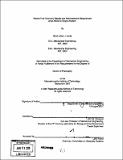Vehicle fuel economy benefit and aftertreatment requirement of an HCCI-SI engine system
Author(s)
Hardy, AliciA Jillian Jackson, 1978-
DownloadFull printable version (65.14Mb)
Other Contributors
Massachusetts Institute of Technology. Dept. of Mechanical Engineering.
Advisor
John B. Heywood.
Terms of use
Metadata
Show full item recordAbstract
This body of work dimensions the HCCI fuel economy benefits and required aftertreatment performance for compliance with emissions regulations in North America and Europe. The following parameters were identified as key factors influencing the benefit of implementing HCCI over driving cycle: * Power-to-weight ratio * Operation range of HCCI * Conditions of the driving cycle * Application of constraints that cause "un-natural" mode transitions * Application of transition penalties * Available after-treatment performance * Constraints imposed by emissions regulations This study shows that development priorities for attaining maximal fuel economy benefit during urban driving cycles differ greatly in North America and in Europe due to differences in emissions regulations. The combined effect of increasing power-to-weight ratio, increasing the operation range of HCCI, removing operational constraints on HCCI implementation, and reducing fuel penalties associated with transitions into and out of HCCI mode is shown to double the emissions-constrained fuel economy benefit of HCCI during the new European driving cycle. These factors are shown to have modest impact on fuel economy benefit of HCCI during the North American city driving cycle when compliance with the more stringent emissions regulations is required. In order to attain maximal fuel economy benefit and comply with emissions regulations in California, improving conversion efficiencies in the aftertreatment of lean engine exhaust must be a primary focus. Fuel economy benefit of HCCI during the highway driving cycles is shown to be most responsive to the amount of time the engine spends in the speed and load range of HCCI operation. Time spent in HCCI mode during these driving cycles is most heavily influenced by changes in power-to-weight ratio and upper load limit for HCCI.
Description
Thesis (Ph. D.)--Massachusetts Institute of Technology, Dept. of Mechanical Engineering, 2007. Includes bibliographical references (v. 2, p. 821-823).
Date issued
2007Department
Massachusetts Institute of Technology. Department of Mechanical EngineeringPublisher
Massachusetts Institute of Technology
Keywords
Mechanical Engineering.